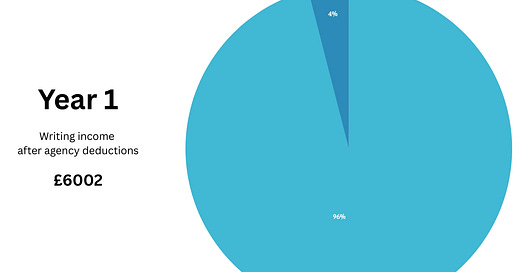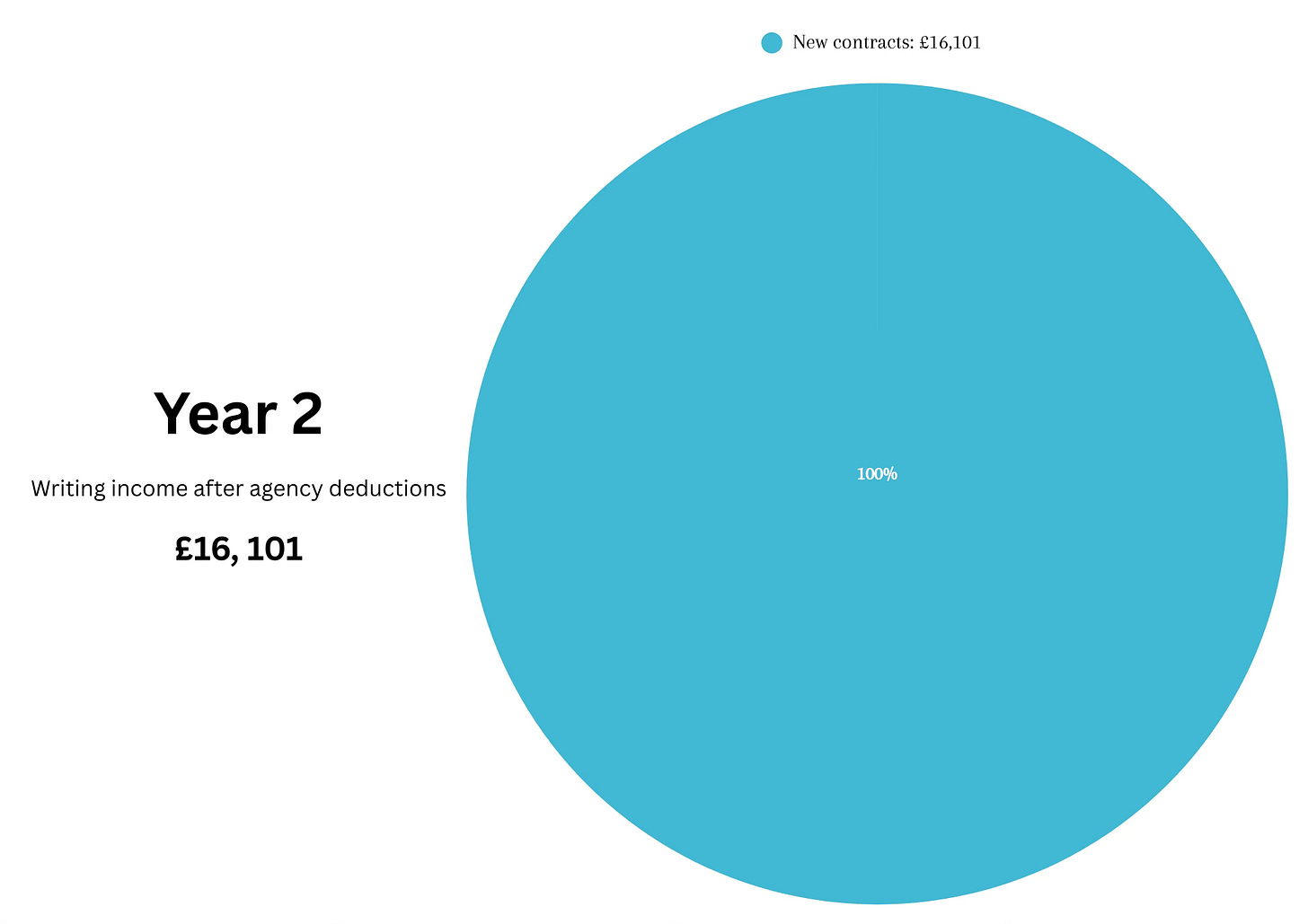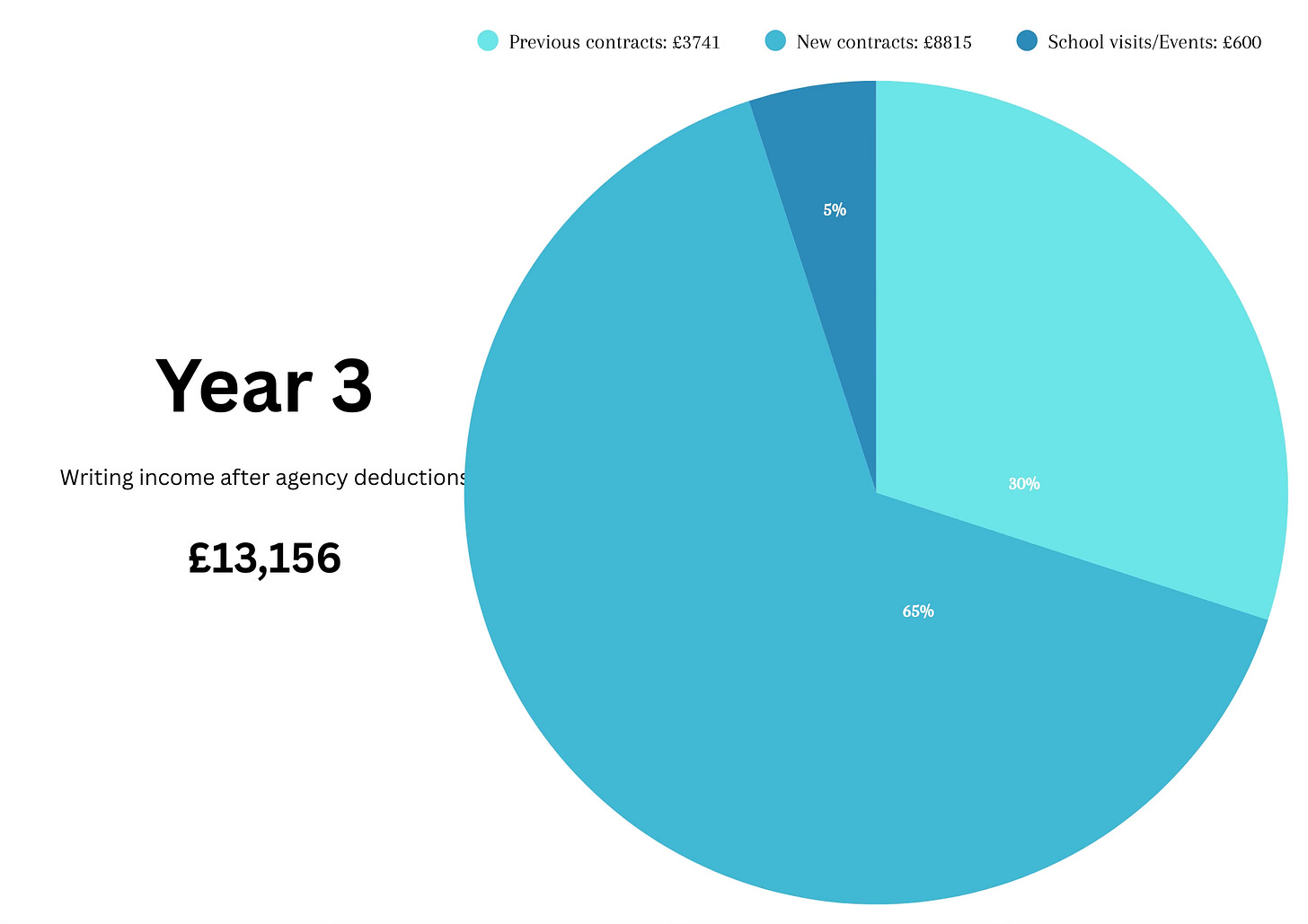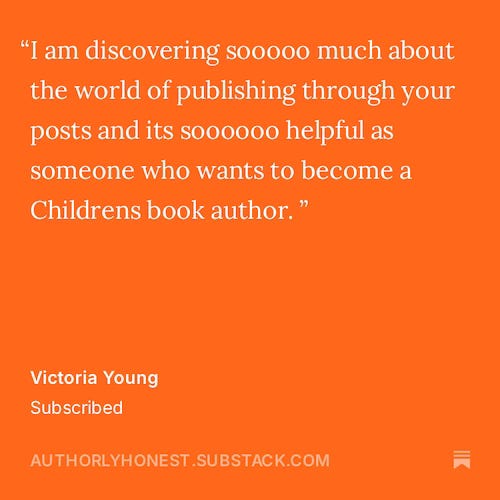My author earnings - Years 1, 2 and 3
A detailed breakdown (including figures) of what I earned in each of my first three years as a children's author
Hi, folks. Welcome to the first post in my new series on author earnings.
If you’re familiar with this Substack, you’ll know that I’ve already published several posts in my Money Matters series, in which I tackle specific topics related to the financial side of author life.
So far, I’ve written about how advances work (sharing details of mine), delved into my sales figures to explain what ‘earning out’ means, and revealed my royalties to date in my almost 9 years as a published author.
But my plan since devising this Substack has always been to share the exact details of my year-on-year author earnings since I signed with my agent in October 2013, as part of my ongoing effort to make the opaque world of publishing more transparent.
So, in this series, that’s exactly what I’ll be doing.
Each post will cover a specific financial year (though this one will cover the first few, in order to make it a little more interesting) and provide you with details of…
my total income from writing for that year.
a breakdown of that income – what I made from each income strand, e.g. advances, royalties, PLR, school visits/events etc
my writing expenses
my writing profit
…as well as some context to that year – how many books I’d already had published, how many were already earning out, whether I was writing part-time or full-time, that sort of thing.
Hopefully, I’ll be able to shed some light on what one might reasonably expect to earn as a children’s author.
Actually, I take that back – because it’s a LUDICROUS statement to make!
I’ve no idea what my peers earn (apart from the newsworthy, headline-grabbing-seven-figure-advance-receiving, exception-to-the-rule ones – and even then, I’d still be guessing.)
Earnings will inevitably vary hugely from author to author, even those at almost identical stages in their careers, due to myriad reasons (including luck and good timing!).
And even I don’t really know what I might reasonably expect to earn from one year to the next – because, as you’ll come to see if you hang around for the full series, writing income is generally shit wildly unpredictable.
That said, what this series will do, at least, is show you what one particular author (me!) earns. And if some of my fellow authors follow suit in future, then we might reach a point when the topic of money in publishing becomes at least marginally less mysterious.
So without further ado, let’s get stuck into those numbers.
Year 1 – The Context
After having a legit ‘menty b’ and consequently withdrawing from my primary PGCE course in May 2013, I began writing children’s stories, did a tiny bit of copywriting, and, after allowing myself a bit of time to get better – made possible because I was living rent-free with my parents (Merci, Mum and Dad!) – returned full-time to the hospitality industry.
In October 2013, I signed with Sallyanne Sweeney (still my fabulous agent) and instantly became a living cliché: the writer who works in a bar.
In November, Sallyanne began submitting my work to publishers, and in April 2014 I received my first offer of a book deal. I signed the contract in August 2014, and another for a second book a month later.
Gosh, I thought, this is easy…and if I carry on at this rate, I’ll be able to quit my job in no time!
Wisely, I didn’t.
Year 1 – income (after agency deductions): £6002
Oh, by the way, do you like pie?
I thought so!
And do you like charts?
I knew it!
In that case, here’s something else I think you’ll like: a pie chart showing a breakdown – not my mental one, fortunately, but rather how that income was split:
My copywriting work brought in a whopping £262.00 (I did say I only did a tiny amount), and included penning a ghost story for a German educational publisher (written in English, thankfully), and a one-off job for a local PR/communications company writing 500-or-so product descriptions for ASDA’s website.
I’m not sure whether it was only ever going to be a one-off job, or it became a one-off job because of the job I did on the job.
Either way, I tried to bring some creative flair to it, and sincerely hope that my description of ASDA’s ‘YOLO’ bath mat (‘You may only live once, but you’ll want to use this luxurious bathmat time after time after time, until you die’) converted at least one browser to a buyer.
New contracts, accounting for £5740, made up the rest of my writing income for that year.
I signed two single-book contracts, with the advances (£3500 per book) split into two payments, on signature and delivery. I received the full amount for both before the end of the tax year.
My expenses for the year – anything I can claim the tax back on, basically – totalled £190 (I definitely added less than I could/should have to my expenses list), so my writing profit for Year 1 was £5812.
Year 2 – The Context
Still working full-time. Still living rent-free with my parents (thanks again, Mum and Dad.)
This was a slightly unusual year, in that I earned absolutely nothing from almost all the writing I did.
The books I’d signed contracts for in Year 1 weren’t published until Year 3, meaning – obviously – that it was impossible to earn any royalty income from them, plus I’d already been paid the full advance for them. No publishers offered for any of my texts in Year 2. So, no further contracts, no income from advances.
Except… I managed to win a pitch to write a picture book on behalf of a very well-known, high-straight health and beauty retailer and pharmacy chain – or at least, the ophthalmic arm of their business.
The company wanted to create a picture book that parents could use to subtly check their child’s visual capability whilst reading for pleasure (with the goal of increasing the uptake of eye tests in store): cleverly weaved into the illustrations (for which I was not responsible, thankfully) were four eyesight tests: an astigmatism check, a colour vision check, a duochrome check, and a visual acuity check.
It also tested me: I had to think up a story in which the images used for those checks would not seem out of place in the illustrations. Also, the brief constantly changed: it was a slightly ridiculous couple of weeks working on the project in the run up to Christmas (I think I submitted the final version the day before Christmas Eve), with very tight turnarounds – whilst working full-time at the busiest time of year in hospitality. I certainly wangled a few favours from my managers to allow me to do it.
But it was worth it: my agent negotiated a flat fee for it of £10,000 – which, even now, 10 years later, is still the highest payment I’ve received for a single book, by a considerable margin, too.
And then, before publication in the spring, the terms and scope of the project changed – consequently, so did the fee.
Initially, the company had planned to have one copy of the book in each branch – so, actually, I think the original vision for the project can’t have been to have parents test their child’s eyesight at home, else how would that have worked?! My memory must be failing me… – but someone at the top loved the result so much that they decided to increase the print run into the hundreds of thousands in order to be able to give the book away to parents for free.
Off the back of this, my agent managed to negotiate an increase to my fee… of £15,000, taking the total fee to £25,000.
For what turned out to be about two weeks’ (hectic) work.
Briefly, I felt like a mid-level professional footballer (without the talent, skill and fitness, of course)!
Sallyanne did an amazing job, and demonstrated fairly early on in our working relationship why she’s such a good agent – not just because of her negotiating skills, but because she was so calm under pressure and a really reassuring, positive presence when things were getting a little unmanageable.
The story itself certainly isn’t my finest writing – but given the challenging brief and timescale, I was pleased with and proud of what I managed to achieve. (And also, my name wasn’t on it, so whatever.)
I remain hugely disappointed, however, that neither I nor Sallyanne nor the illustrator were invited to the launch party for the book, held at a 5-star hotel in London, at which various celebrities and book/parenting-influencers rubbed shoulders with each other – and a lemur. And a parrot. And snakes, millipedes and cockroaches (if it’s anatomically possible to rub shoulders with them). This isn’t quite as random as it sounds, as the book was zoo-themed.
The project was also backed by the National Literacy Trust, and fronted – naturally – by Peter Andre.
I wonder how much he got paid?
Anyway, all-in-all, it meant that my Year 2 income was a significant improvement upon that of Year 1…
Year 2 – income (after agency deductions): £16,101
Here’s that same information in very helpful pie chart form:
I received 3 of the 4 payments for the project in Year 2.
My writing expenses for the year totalled £126, meaning that my writing profit for Year 2 was £15, 975.
Year 3 – The Context
Still working 30+ hours a week in hospitality, though I condensed these into fewer days to enable me to have more days to write.
For the first five months of tax year 3, I was still living rent-free with my parents (thanks yet again, Mum and Dad), until I bought and moved into a shared-ownership flat in September.
Year 3 was the year in which I became a published author – hooray!
Once my second book had been published, I also started dipping my toes into the terrifying waters of school visits and events, doing a few for free to get a feel for them, before starting to charge a fee.
I’ll admit that I was reluctant to do school visits – I was still a bit scarred from my PGCE nightmare – and that I didn’t go to any great lengths to try and secure many: that only really changed many years later when I gave up the reliable income stream of my hospitality job and needed to make up the shortfall.
Year 3 – income (after agency deductions): £13, 156
Writing-wise, Year 3 was a relatively successful one, for as well as having my first two books published, I signed two contracts, for four books in total:
I signed a 1-book contract, the £3000 advance for which was split into three payments, and I received the first two in Year 3.
I also signed a contract for three picture books. The advance for each was £4750, split into two payments. In Year 3, I got paid the signature portion for all three books, plus the delivery portion for one of the books (so 4 out of 6 payments).
Therefore, new contracts accounted for £8,815 of my Year 3 income.
I also received the fourth and final payment from the eye-test picture book contract signed the previous year, so income from previous contracts amounted to £3741.
I did a single two-day school visit, which brought in £600.
My writing expenses for the year totalled £184, meaning that my Year 3 writing
profit was £12,972.
And there we have it: a detailed look at what I earned from my first three years as an author of children’s books.
Things get slightly more interesting year-by-year, I’d say, with an increase in the number of strands that make up my income – such as royalties and Public Lending Right – and big fluctuations in the amount each strand provided. So look out for the next post in this series!
Until then, I hope you enjoyed this post. And, as always, if you did, please like, comment and share, as it really does give this Substack (and me!) a boost!









A great post, thanks Simon! (And, as ever, Peter Andre)
Thanks for this Simon very informative again !
Can’t believe they didn’t invite you to the launch party for the eye test book ! So mean 😢🙃😂